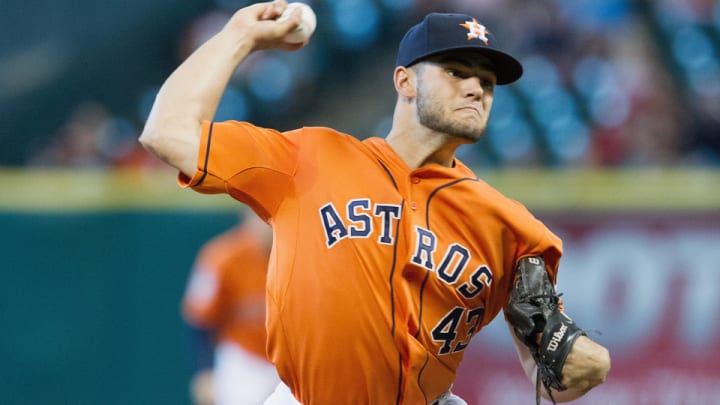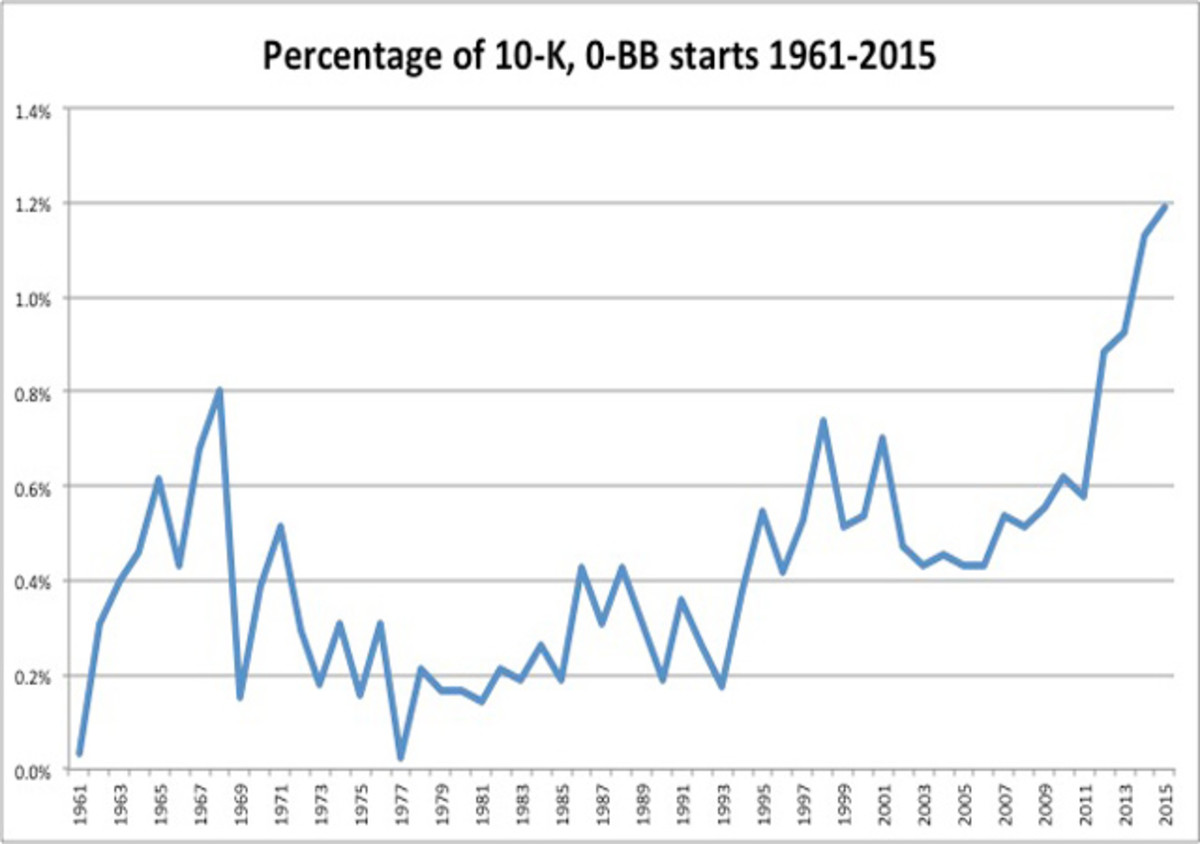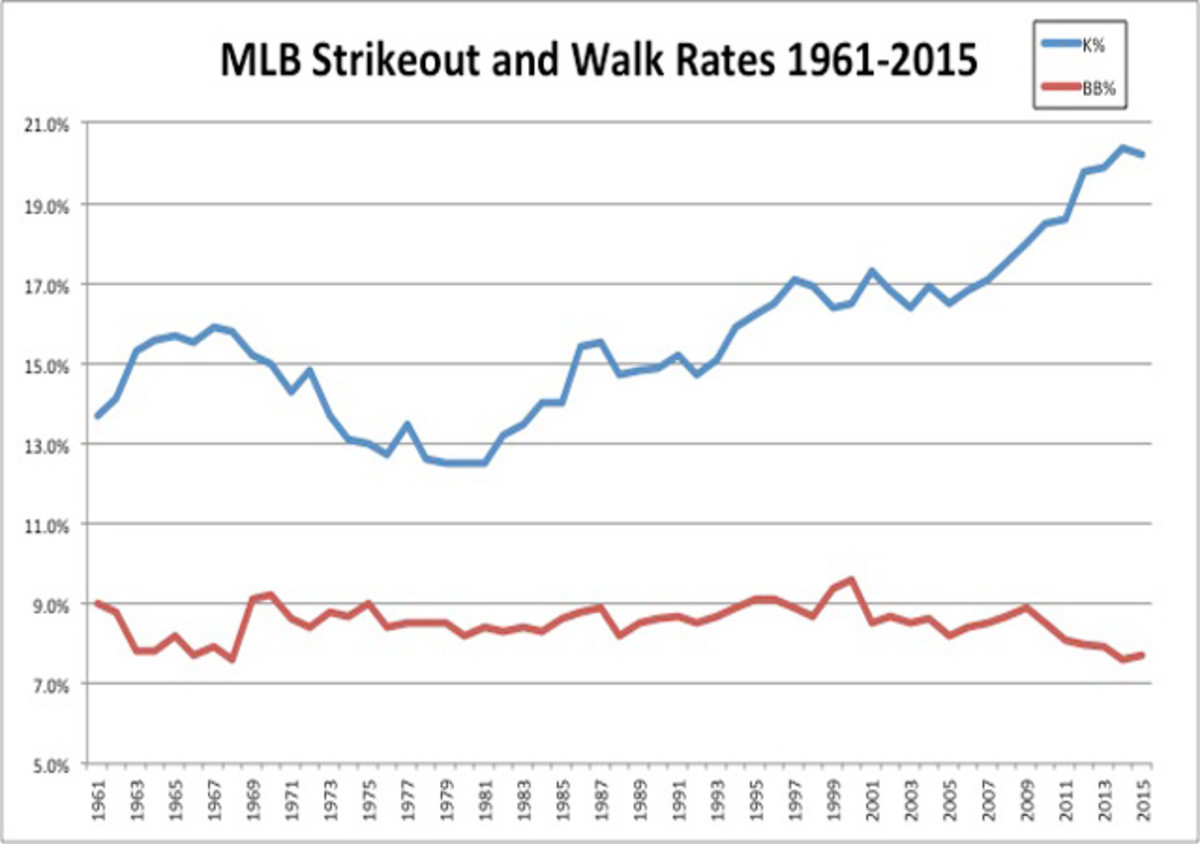Lance McCullers's 10-strikeout, zero-walk game illustrates bigger trend

On Wednesday night, Astros rookie Lance McCullers went the distance against the Orioles, striking out 11 without walking a batter. On Tuesday, it was the Rays' Chris Archer whiffing 15 Angels without walking a hitter over eight innings, and the Mets' Noah Syndergaard somehow interspersing 10 strikeouts with 10 hits allowed over four laborious but walk-free innings against the Padres. That latter outing was a near mirror-image of what San Diego's Andrew Cashner had done against New York the night before over 4 2/3 hit (11) or miss (12 K) innings. The same night, the Cubs' Jason Hammel struck out 11 Marlins without walking a batter. On Sunday, it was McCullers's teammate, Dallas Keuchel, with an 11-strikeout, no-walk, four-hit shutout of the White Sox, whose own Chris Sale whiffed 12 without a walk just last Thursday…
This is getting ridiculous. Welcome to the rise of the 10-strikeout, no-walk start, part of a larger trend in which strikeout and walk rates continue to diverge, putting pitchers at an increased advantage for reasons I’ll get to below. Three days worth of games in June have produced five such efforts, the past nine days have seen nine of them, and an astronomical 17 have been recorded over the past 28 days, starting with the Nationals' Max Scherzer on May 6. This after there were only two such games in April: the Dodgers' Brandon McCarthy did it on April 13 and the Astros' Collin McHugh followed two days later. Here is the complete list of 19.
Awards Watch: Donaldson, Trout neck and neck for lead in AL MVP race
What gives? Before sinking our teeth into the larger trend, let's have a moment for McCullers. The son of a reliever who spent seven years in the majors (1985–90 plus '92) pitching for four teams, Lance the Younger was chosen out of a Tampa high school with the 41st pick of the 2012 draft, a supplemental pick to compensate for the loss of Clint Barmes from the same round in which the Astros took Carlos Correa first overall. After making four starts apiece in two Rookie leagues in '12, McCullers held his own in the Class A Midwest League in '13, but he got cuffed for a 5.47 ERA in the High A California League last year, a notoriously hitter-friendly circuit, despite whiffing 10.7 per nine. He moved up to Double A this year, and after dominating—29 innings, 15 hits, 43 strikeouts, three runs—in just four starts and two relief appearances for Corpus Christi, the 21-year-old righty made his major league debut on May 18 against the Athletics. While he lasted fewer than five innings in two of his first three starts, he allowed just four runs in 15 innings, whiffing 18 and walking just six.
Kris Bryant or Carlos Correa: Which super prospect would you choose?
McCullers put it all together on Wednesday night, scattering four hits over the course of nine innings and 107 pitches. The Orioles' lone run came in the fourth inning via a one-out Adam Jones triple and a two-out Delmon Young single, after which he retired the next 15 hitters; Jones's two-out single in the ninth inning broke the spell before he struck out Chris Davis to end the game. Via Brooks Baseball, McCullers relied almost exclusively on a fastball-curve combo (61 of the former, 37 of the latter), mixing in just nine changeups. He averaged an impressive 95.9 mph with the heater, topping out at 98.5, and he recorded 10 swings and misses from among the 18 curves at which Baltimore swung. His first strikeout came on a fastball, but the rest of them—three looking, seven swinging, including the final five—came on the curve. Young was the only Orioles hitter not to be rung up, while Davis, Jones and Ryan Flaherty went back for seconds. Here's the highlight reel:
At 21 years and 244 days, McCullers became the youngest pitcher with a complete game featuring a double-digit strikeout total since Kerry Wood's 20-K masterpiece on May 6, 1998; Wood was 20 years and 324 days. McCullers does have the distinction of doing so earlier in his major league career (fourth start) than Wood (fifth). Only five pitchers have recorded 10/0 games earlier in their careers, with one repeating the feat, and one matching McCullers:
game | player | date | team | opp. | ip | k | gm sc. |
|---|---|---|---|---|---|---|---|
1 | 6/8/10 | WSN | PIT | 7 | 14 | 75 | |
1 | 4/3/08 | CIN | ARI | 7 | 10 | 81 | |
2 | Andy Sonnanstine | 6/10/07 | TBD | FLA | 7 | 10 | 65 |
3 | Stephen Strasburg | 6/18/10 | WSN | CHW | 7 | 10 | 75 |
3 | Frank DiPino | 9/7/82 | HOU | SDP | 5 | 10 | 55 |
3 | Dennis Ribant | 8/17/64 | NYM | PIT | 9 | 10 | 89 |
4 | Lance McCullers | 6/3/15 | HOU | BAL | 9 | 11 | 86 |
4 | 9/24/13 | SEA | KCR | 7 | 10 | 79 |
As you can see, such outings don't guarantee a lifetime of success, though they're still quite cool. Note that McCullers was just the second pitcher to throw a complete game under such circumstances, and that his Game Score is second only to that of Ribant.
McCullers's gem made Houston the first team to record three such starts this season, while Tuesday's effort by Archer was his second in a row, making him the only pitcher to repeat this year. The outings of Cashner and Syndergaard were the first two since 1914 (at least) in which pitchers yielded at least 10 hits and struck out 10 in less than five innings.
If it seems as though these games are growing in frequency, you’re not wrong. They breached the 1% mark for the first time last year, and thanks to the recent wave, they’re above that line again:

.
rank | player | 10/0 games started |
|---|---|---|
1 | Randy Johnson | 36 |
2 | Curt Schilling | 27 |
3 | Roger Clemens | 21 |
4 | Pedro Martinez | 18 |
5 | 13 | |
6 | Mike Mussina | 12 |
7 | Javier Vazquez | 11 |
8 | Tom Seaver | 11 |
9 | John Smoltz | 10 |
10 | 10 |
Adrian Gonzalez defying recent trends with scorching start for Dodgers
Atop the list is the Big Unit, whose 4,875 strikeouts rank second all time to Nolan Ryan, who had eight such games. Johnson ranks eighth since 1893 (the year the 60'6" distance was established) in terms of career strikeout-to-walk ratio among pitchers with at least 2,500 innings, a top 10 that is well-represented above via Schilling (first at 4.38), Martinez (second at 4.15), Mussina (fifth at 3.58), Vazquez (seventh at 3.32), Smoltz (13th at 3.05) and Clemens (14th at 2.96). Lee doesn't crack the latter leaderboard due to his early control troubles, but since the start of the 2008 season, he's led the league in K/BB three times, and his 6.10 over that 1,415-inning span is miles beyond Schilling. Among active pitchers (of which Lee is technically one, though potentially facing the end of his career due to an elbow injury), below King Felix are Zack Greinke, Clayton Kershaw, David Price and Johan Santana (nine apiece), followed by John Lackey, Scherzer, and James Shields (seven), then Madison Bumgarner at six.
Back to the all-time list: Note that Seaver is the only pitcher from among the upper echelon whose career did not cross into the post-1992 expansion era. That's because strikeout rates have risen sharply in that span, while walks have fallen slightly. In '92, batters whiffed in 14.7% of plate appearances and walked in 8.2% of them, numbers that weren't all that different from '72 (14.8% and 8.4%) or even '62 (14.1% and 8.8%) despite some variance in between, due to multiple redefinitions of the strike zone:

Strikeout rates reached 17% for the first time in 1997, and while they didn't reach 18% until 2009, they were up to 19.8% by '12 and have advanced even further since; they're at 20.2% currently, down from a high of 20.4% last year. Meanwhile, walk rates hovered between 8–9% from '69 (when the mound was lowered and strike zone redefined in response to 1968's Year of the Pitcher) to '12, but in the last three years, they've dipped below 8.0% for the first time since that pivotal season. Strikeout-to-walk ratios, which prior to 2005 had only crossed 2.0 during the '66–'68 span, have been above 2.0 since and have set new all-time highs every year from '10–'14: 2.17, 2.30, 2.48, 2.51, 2.67. They're down a whisker from last year, at 2.63 now.
May All-Stars: Harper, Kipnis, Fielder lead list of month's top players
Underlying the long-term increase in strikeouts has been a decreased stigma against them on the offensive side (they correlate positively with hitting for power and avoiding double plays) and the sharp rise in pitchers throwing at least 95 mph; they are being used in increasing numbers, particularly out of the bullpen. Helping or hurting matters (depending upon how you feel about the trend) is the expanding strike zone itself, which can be measured via the flood of PITCHf/x data now available. As documented by Jon Roegele of The Hardball Times—a heavy-hitting researcher who keeps the detailed Tommy John surgery database and who has done fascinating work on the topic of pitch sequencing—the strike zone has expanded significantly since the start of the 2009 season, particularly at the bottom of the zone, the area 21 inches off the ground or lower, which roughly translates to the area below the batter's knees. Here's his most recent table, published on May 29:
year | zone size (Sq. in.) | zone size below 21" | K% | R/G |
|---|---|---|---|---|
2009 | 435 | 0 | 18.0 | 4.61 |
2010 | 436 | 6 | 18.5 | 4.38 |
2011 | 448 | 11 | 18.6 | 4.28 |
2012 | 456 | 19 | 19.8 | 4.32 |
2013 | 459 | 30 | 19.9 | 4.17 |
2014 | 475 | 47 | 20.4 | 4.07 |
2015 | 478 | 51 | 20.1 | 4.19 |
As noted above, this season's strikeout rate has risen to 20.2% just since the article was published, while scoring is down to 4.16 runs per game. Note that the area of the zone below 21 inches is 4.6 times what it was in 2011, 2.7 times what it was in '12, and 1.7 times what it was in '13. At this rate, it could engulf the Eastern Seaboard by the All-Star break.
Power Rankings: Cardinals back in first, Pirates rise, Tigers take a fall
In an earlier study, Roegele noted that pitchers have increased the frequency with which they throw into the 18–24 inch range from 16.9% in 2008 to 18.3% last year. Pitchers are being rewarded for their efforts, while batters, who increasingly find themselves at a disadvantage, have increased the frequency with which they swing at such pitches, going from 45.6% to 49.2% in the same span. Those changes have gone hand in hand with the rise in strikeout rates and drop in scoring. Research independent of Roegele's, by Brian Mills, attributes between 25% and 40% of the decline in scoring to the larger strike zone.
If there's good news, it's that those low pitches are being called similarly with more consistency from umpire to umpire, but the trend is still one that's producing games that are both lower scoring and with less in-play action—games less aesthetically desirable, in the eyes of many. All of this points to the notion that if new commissioner Rob Manfred and the other powers that be want to give scoring a nudge in the other direction, a re-emphasis or even redefinition of the strike zone's boundaries is the place to start.
That's an issue for another day. In the meantime, while the individual efforts are certainly worth appreciating, it would appear that games such as the ones McCullers, Archer and friends have thrown are becoming just another feature of the current landscape.
